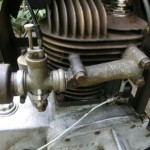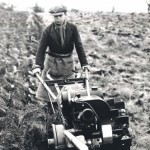Home › Forums › The Machinery Forums › Pedestrian operated machines › Howard the Hunter.
- This topic has 4 replies, 3 voices, and was last updated 2 years, 2 months ago by
rjy.
-
AuthorPosts
-
October 28, 2022 at 6:05 pm #40150
rjy
ParticipantHoward 350. Starts easily, but at idle it “hunts” which becomes less noticeable at fast idle and under load. Under load, is it as powerful as I found it 30 years ago? Don’t know, just a feeling it might not be, but then again that piece of ground had far less roots, ‘cos I’d rotavated it a lot! So it goes “BrrrrMM, brrrrMM, brrrrMM, brrrrMM” etc. instead of “Blat blat blat blat”. I cleaned the carburettor out before running it, it has had a head job (gasket, decoke), it has a new exhaust, it’s running on E5 petrol, and has its original points and capacitor.
Do I need to twiddle something on the carburettor (main jet screw) or something? What, any ideas, please?
October 28, 2022 at 8:47 pm #40151 wristpinParticipant
wristpinParticipantHunting at idle is usually caused by a weak mixture, either that there is sill some obstruction in the slow running system or just needing an adjustment of the slow running jet. From memory, assuming a Kohler engine, the main jet adjustment is the vertical slot head screw and the slow running one is at an angle. An image of the carb will confirm or otherwise.
October 31, 2022 at 11:55 pm #40152rjy
ParticipantThat’s right. It is the original Kohler carburettor, with a main jet adjustment going vertically down, an angled idle jet, and a horizontal screw for idle speed adjustment.
Currently the main jet is set 1 3/4 turns out, the idle jet 2 1/4 turns out, not that it’s particularly a fixed setting, even from new (although I don’t think I have ever adjusted these before).
After the 25-year or thereabouts gap in operation, there was some varnish in the carb, but I soaked it in acetone, and blew through the various holes and galleries with compressed air, so hopefully they are clean.
Is carburettor adjustment likely to be the culprit, rather than control cables, governer? I hope so!
November 1, 2022 at 10:16 am #40154 trusty220Keymaster
trusty220KeymasterCarburettor adjustments are the first step in the process and nine out of ten times you will find that they cure the problem.
Don’t start fiddling with governor settings or anything else until you’ve adjusted the fuel/air mixtures, you will only make the matter worse.
Start by setting the main jet- run the engine at working speed and screw the main jet in slowly until it runs rough; note the position of the screw head. Then unscrew it back out again slowly- it will run smoothly then rough again the more you screw it out- again, note the position of the screw head when it starts to run rough again.Screw the main jet in halfway between these two positions and you will find that it will run smoothly at it’s working speed.
Next, turn your attention to the idle mixture screw. Run the engine at a slow idle and perform the same process with the idle mixture screw. Once it’s running smoothly at idle you can then reduce the revs using the external screw on the throttle lever.
You haven’t finished yet!
When you increase revs from idle, does the engine hesitate before it picks up? If it does you will need to richen up the idle mixture slightly. The reason is that when idling the butterfly is nearly closed with only a small gap between it and the venturi wall. If you look closely inside the venturi you will see some small holes drilled just where the butterfly meets the wall- this is where the fuel/air mixture from the idle jet comes out and it not only allows the engine to run evenly at idle but also helps with the acceleration from idle to working speed. If it hesitates you either have one of the holes blocked or the mixture is too weak to bridge the gap between idle and working speeds.
It sounds complicated but it takes less time to do it than to read this piece!
Good luck!April 6, 2023 at 8:04 pm #40696rjy
ParticipantA belated thank you! Coming home from the alottment the other day I twiddled trhe vertical screw, and 3/4 turns out from where it was and it ran very well. Next step is to rotavate again, and then check the plug.
-
AuthorPosts
- You must be logged in to reply to this topic.
